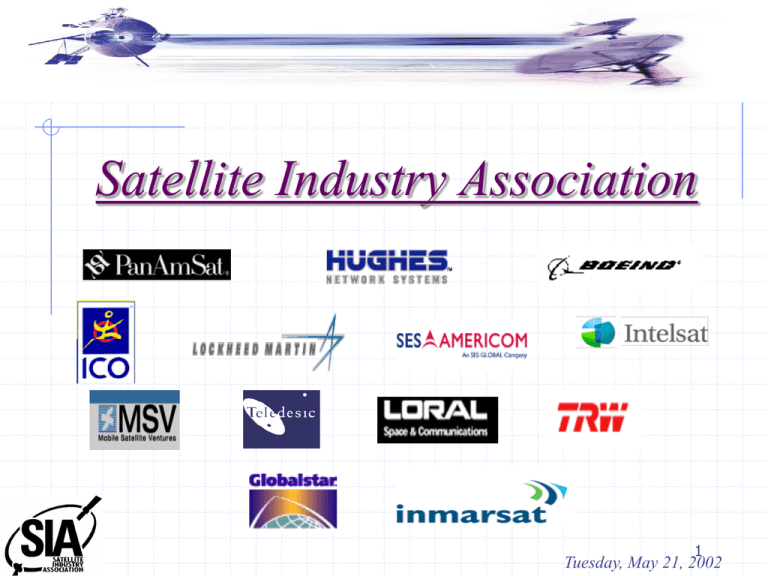
Satellite Industry Association
1
Tuesday, May 21, 2002
Satellite Industry Overview
Services & Applications
GPS/Navigation
• Position location
• Timing
• Land/Sea Rescue
• Mapping
Communications
• Wireless Networks
• Messaging
• Telephony
• Mobile Satellite phones
• Internet Backbone
• VSAT’s
• Credit Card Validation
Broadband
• Tele-Medicine
• Tele-Education
• Internet to end-user
• Videoconferencing
Remote Sensing
• Oil pipeline monitoring
• Rail Management
• Infrastructure Planning
• Forest Fire Prevention
• Urban Planning
• Flood and Storm watches
• Air Pollution management
DBS/DARS
• Direct to Consumer TV & Radio
• Broadcast and Cable Relay
• National Emergency Broadcast
System
Support Services
Launch Vehicles Ground Equipment Insurance Manufacturing
2
Satellites Are Critical Infrastructure
Satellites are critical to economy, defense
Backbone of national TV, radio, and print media
distribution
Billions of data, credit, banking transactions daily
Primary information source to millions of Americans
Essential to flexible global defense infrastructure
Satellites are a reliable infrastructure component
Largely independent of terrestrial network
Space assets out of reach, satellites and gateways
redundant
Essential for disaster relief and recovery
3
US Satellites and National Security
Communications (Voice, Data, Direct Broadcast)
Position, Navigation and Timing
Early Warning, Tracking and Targeting
Meteorological Observation
Intelligence, Surveillance and Reconnaissance
Technology, R&D, Experimentation
4
Terrestrial Re-use of Satellite
Spectrum
5
Digital Audio Radio Services (DARS)
Applications in the early 1990’s proposed terrestrial
repeaters to compensate for signal loss in urban canyons and
rough terrain
FCC allocated DARS spectrum in competitive auction in
1997
Adjacent Wireless Cable Service (WCS) interference
concerns and local radio content issues still being considered
Part 15 issues – WiFi and Bluetooth
FCC temporarily approved terrestrial repeater service in
2001 but has yet to issue final license rules
6
Mobile Satellite Services
Satellite hybrid network proponents seek to combine the
advantages of cellular and satellite systems
Terrestrial opponents charge that hybrid systems are an
end-run around standard auction process
Satellite operators maintain that international satellite spectrum
is unique
Arguments as to whether a single entity is needed to
operate both the terrestrial and satellite component of
spectrum
7
Digital Broadcast Satellites (DBS)
FCC recently announced that it will authorize MVDDS under
the FSS allocation in the 12 GHz band
MVDDS will share band with DBS and NGSO-FSS on coprimary (but non-interference) basis subject to service and
technical rules
FCC adopted a geographic licensing scheme and will assign
terrestrial licenses via auction
DBS, post-1993 spectrum purchased at auction
Satellite television operators are concerned that significant
interference will occur if terrestrial re-use is allowed
8
Other Key Satellite Spectrum
Issues
9
Radar Detector Interference
Satellite operators and their customers have suffered,
and continue to suffer significant harm from radar
detector interference
Radar interference often in excess of 100 X Part 15
interference criteria
Problems occurring across 10.7 - 12.7 GHz band
Satellite industry requesting current radar detectors off
the market ASAP
10
2 GHz MSS Spectrum
Nextel Proposal (800 MHz)
Nextel seeks 10MHz of MSS spectrum for its 800
MHz band realignment plan
Proposed reallocation would hinder critical MSS
services and other 800 MHz interference fix exists
3G
Optimistic estimates suggested that demand for 3G
services might create urgent spectrum needs
Licensees need entire band to ensure growth and
success of 2GHz MSS systems
11
Satellite Licensing Reform
Reducing processing time
Addressing mutual exclusivity
Discouraging speculative filings and ‘green mail’
Preserving replacement expectations
Developing meaningful milestones
Reduce need for interpretation and enforcement
12
Orbital Debris NPRM
FCC recently released all-encompassing NPRM
regarding Orbital Debris policies and practices
The current policy of a “self-policed” industry works
well for US based GEO satellite operators:
Industry is highly motivated for economic reasons
No collisions to date
U.S. has maintained excellent de-orbit record
13
New Uses for Satellite Spectrum
14
The Future of Air Traffic Management
Communication
Satellites
GPS
Satellites
Integrity-WAAS
ADS-Broadcast
Satellites are central to
FAA’s future plans
Navigation
Communications
Emergency beacons
ADS-B Data
Free Flight Aircraft
Air Traffic
Advisories and
Intervention
Instructions
Air Traffic
Controller
Increased emphasis on
real-time threat response
Plane tracking
Cabin surveillance
Black-box telemetry
“Safe mode” controls
15
Evolution Satellite Broadband
Ka-band
Satellites
Ku-band
Satellites
(from 2003)
(Existing)
30 Mbps
Output from
Satellite
400+ Kbps to User
128-256 Kbps from User
400+ Mbps
Output from
Satellite
30+ Mbps to User
512+ Kbps from User
Copyright ©2002, Hughes Network Systems, All rights reserved
16








